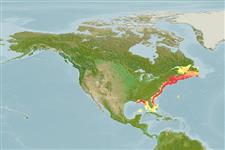>
Gadiformes (Cods) >
Phycidae (Phycid hakes)
Etymology: Urophycis: Greek, oura = tail + Greek, phyke, pykis, -idos = the female of a fish that lives among algae (Greek = phykon), related with the gudgeon (Ref. 45335).
More on author: Walbaum.
Environment: milieu / climate zone / depth range / distribution range
Ecologia
marinhas demersal; não migratória; intervalo de profundidade 0 - 494 m (Ref. 57178), usually 110 - 185 m (Ref. 1371). Subtropical; 52°N - 23°N, 90°W - 53°W (Ref. 56857)
Northwest Atlantic: Canada to southern New England to the northeast coast of Florida; also found in the northeastern Gulf of Mexico.
Tamanho / Peso / Idade
Maturity: Lm ? range ? - ? cm
Max length : 43.0 cm TL macho/indeterminado; (Ref. 49746); common length : 17.0 cm TL macho/indeterminado; (Ref. 1371)
Espinhos dorsais (total): 0; Espinhos anais 0. Upper limb of the first gill arch with 2 or 3 rakers. Head with a series of dark spots; opercle with a dusky blotch. First dorsal fin with a dark blotch and a distinct white margin.
Found onshore, most common between 110 and 185 m. Feed on crustaceans, and possibly fish and squids. Juveniles spend part of their time in estuaries.
Ciclo de vida ou comportamento de acasalamento
Maturidade | Reprodução | Desova | Ovos | Fecundidade | Larvas
Cohen, D.M., T. Inada, T. Iwamoto and N. Scialabba, 1990. FAO species catalogue. Vol. 10. Gadiform fishes of the world (Order Gadiformes). An annotated and illustrated catalogue of cods, hakes, grenadiers and other gadiform fishes known to date. FAO Fish. Synop. 125(10). Rome: FAO. 442 p. (Ref. 1371)
Status na Lista Vermelha da UICN (Ref. 130435)
Ameaça para os humanos
Harmless
Uso pelos humanos
Pescarias: pouco comercial
Ferramentas
Relatórios especiais
Baixar XML
Fontes da internet
Estimates based on models
Preferred temperature (Ref.
123201): 5.2 - 22.6, mean 7.6 °C (based on 46 cells).
Índice de diversidade filogenética (Ref.
82804): PD
50 = 0.5044 [Uniqueness, from 0.5 = low to 2.0 = high].
Bayesian length-weight: a=0.00490 (0.00406 - 0.00590), b=3.14 (3.09 - 3.19), in cm total length, based on LWR estimates for this species (Ref.
93245).
Nível Trófico (Ref.
69278): 4.4 ±0.0 se; based on diet studies.
Resiliência (Ref.
120179): médio(a), tempo mínimo de duplicação da população 1,4 - 4,4 anos (Preliminary K or Fecundity.).
Fishing Vulnerability (Ref.
59153): Low to moderate vulnerability (33 of 100).
Nutrients (Ref.
124155): Calcium = 69.2 [29.4, 153.8] mg/100g; Iron = 1.01 [0.55, 1.87] mg/100g; Protein = 18.6 [17.3, 20.0] %; Omega3 = 0.425 [0.220, 0.814] g/100g; Selenium = 34.2 [16.9, 71.4] μg/100g; VitaminA = 14.9 [4.4, 50.8] μg/100g; Zinc = 0.609 [0.413, 0.904] mg/100g (wet weight);
